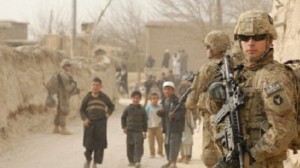Military Connection: Should US Stay in Afghanistan? By Debbie Gregory

Combat operations may have concluded for American forces in Afghanistan, but that does not necessarily mean that the war is over.
On December 28, 2014, an end of mission ceremony was held in Afghanistan’s capital city, Kabul. International Security Force (ISAF) commander, U.S. Army General John Campbell, saw the end of the 13-year long Operation Enduring Freedom, and will now lead the ISAF in its initiation of Operation Resolute Support.
Last year, leading up to the change of operation, the U.S. began rapidly moving personnel and supplies out of Afghanistan. In February, 2014, the U.S. had approximately 34,000 service members on the ground in Afghanistan. At the time of the December 28thceremony, there were 10,600 Americans on the ground. The drawdown also saw the number of U.S. controlled bases go from 87 to 25. The number of U.S. military vehicles went from 17,800 to 5,168 in the same timeframe. The ISAF estimates that 38,410,000 pounds of air cargo were moved by fixed and rotary wing aircraft, in support of the drawdown, between February 1stand December 30th, 2014.
Under the current U.S. drawdown strategy, the plan is to leave roughly 13,000 ISAF troops, consisting of 10,600 U.S. service members and approximately 2,000 NATO personnel on the ground in Afghanistan. These troops will train and advise the army and police forces, as well as conduct counter-terrorism operations. The American force size is scheduled to trim down to 5,500 by the end of 2015, with all U.S. forces scheduled to leave Afghanistan by the end of 2016.
But as Operation Resolute Support begins, there are leaders from both the U.S. and Afghanistan who believe that the drawdown plan should remain fluid.
General Campbell is reported to have said the following on “60 Minutes:”
“There is a lot more talk, from many of the senior leaders I deal with, on the Afghan Security Forces, about Iraq and Syria and what’s going on, and saying, ‘Hey, the coalition left Iraq, and a couple years later, look what happened. Don’t let that happen to us here in Afghanistan,’ ”
On January 4, 2015, Afghanistan’s President Ashraf Ghani told “60 Minutes” that there may come a time when he and President Obama will need to revisit the strategy and deadline for U.S. force withdrawal from Afghanistan.
“If both parties, or, in this case, multiple partners, have done their best to achieve the objectives and progress is very real, then there should be willingness to re-examine a deadline,” Ghani said in the “60 Minutes” interview.
But one of the most perceptive remarks that most Americans should take notice of came from Supreme Allied Commander-Europe, General Philip Breedlove in an article for “Stars and Stripes.”
“All of us as commanders have reminded our senior leadership … the war in Afghanistan has not ended, (just) the combat mission for NATO.”
Americans should not be surprised when news stories report more U.S. casualties in Afghanistan, despite the declared end to NATO’s combat mission. And the frequency of these reports and the quantity of casualties that they report could help measure if Afghanistan’s future will mirror what we are currently seeing in Iraq, just a few short years after the drawdown there.
We at Military connection would like to hear your feedback: Should the U.S. maintain its current drawdown strategy in Afghanistan? Or alter it in some way? Send your feedback to [email protected]
Military Connection proudly serves those who serve in the Army, Navy, Air Force, Marines, Coast Guard, Guard and Reserve, Veterans and their Families. We are the go to site for Veteran Employment and information on Veteran education. Militaryconnection.com provides Veterans with and Directory of Employers, a Job Board, information on the Post-9/11 GI Bill, and a blog that offers Veterans boundless information. Be sure to visit Militaryconnection.com, the go to site.
Military Connection: Should US Stay in Afghanistan? By Debbie Gregory

















